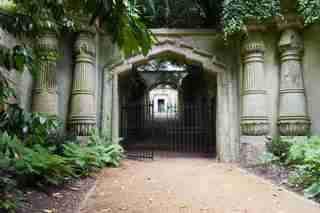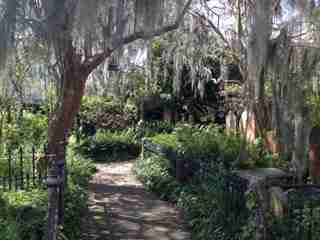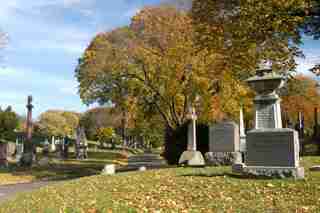August 23,2022
16 Incredible Cemeteries with Breathtaking Designs
by David Stewart
You already know that botanical and sculpture gardens are flush with beauty. Lesser known in terms of flora, fauna, and quiet meditation are cemeteries and churchyards. Set aside the spooky connotation and it’s easy to spot folklore, stunning architecture, deeply cultural significances, and the most hidden green spaces yet (think draping ivy and stone sculptures). Cemeteries such as Paris’s Père Lachaise are havens for not only fans of art, opera, rock ’n’ roll, and literature (among those buried here are Jim Morrison and Frédéric Chopin) but also urban hikers thanks to rolling hills, while headstones at Romania’s Merry Cemetery gleam with cobalt blue and highly personalized ornate designs in ode to the deceased. Tucked into small towns across the U.S.—including spots in Vermont and South Carolina—these destinations rival local museums but are off the beaten path. Just in time for Halloween , we’ve gathered 16 cemeteries around the world that boast intriguing histories and must-see architecture.

Highgate Cemetery, London
Lovers of '80s music are traveling here en masse since George Michael’s March burial (though his gravesite is not accessible to the public). It's also the final resting place of other notables like philosopher Karl Marx, but there are many other reasons to visit. Guided tours of the West Cemetery take you to mausoleums and the Terrace Catacombs (thought to comprise England’s earliest surviving asphalted building). Talks by authors about history, art, and Victorian topics are hosted often and published on the cemetery’s website.

Unitarian Church in Charleston, Charleston, South Carolina
Behind an unassuming iron gate off of King Street, this churchyard—with wildflowers, Spanish moss, camellias, and crepe myrtles—is connected to the Unitarian Church in Charleston , whose English Perpendicular Gothic Revival structure dates back to 1787 and is a National Historic Landmark. Volunteer docents lead tours of the sanctuary (featuring a fan-vaulted ceiling and hand-painted glass windows) between September and mid-June on Fridays, Saturdays, and Sundays.

Green-Wood Cemetery, Brooklyn
Set on 478 acres in Brooklyn, Green-Wood Cemetery features a number of architectural landmarks, including Gothic Revival gates built during the Civil War by architecture firm Richard Upjohn & Son and a 1911 chapel by Warren & Wetmore. The cemetery has a number of famous permanent residents, among them Louis Comfort Tiffany, Jean-Michel Basquiat, and Leonard Bernstein.
St. Louis No. 1, New Orleans
New Orleans is known for its cemeteries filled with ornate tombs and wall vaults. The oldest of these landmarks is St. Louis No. 1, which was founded in the late 1700s and is the burial site of many prominent New Orleans families (and the future resting place of Nicholas Cage). The maze of vaults was featured in the movies Cincinatti Kid and Easy Rider.
Church of Saint Mary’s, Whitby, England
A proper old abbey in Yorkshire, the Church of Saint Mary’s humble cluster of headstones is best remembered as the backdrop of a grisly moment from Bram Stoker’s novel Dracula , which was later adapted for film. The graveyard, which was established in the early 12th century, made headlines recently when devotees of Whitby’s Goth Weekend were banned from posing among the graves and, again, when millennia-old remains were found emerging from the eroding cliff face. Bibliophiles remain welcome to visit this slice of literary and pop-cultural history—just no selfies, please.
Père Lachaise, Paris
The establishment of Paris’s largest and, ultimately, most visited cemetery in 1804 determined what a fashionable burial would look like for the better part of the next century. The sprawling grounds and contemplative paths drew the attention of curious and pioneering spirits, but it was the transfer of the remains of the tragic romantic figures Héloïse and Abélard that solidified Père Lachaise and its daring garden like design as the blueprint for a new urban staple—the public cemetery. Rock ballads and witticisms can sometimes be heard echoing through the tombs today as visitors pay their respects to two of the cemetery’s most in-demand permanent residents: Jim Morrison and Oscar Wilde.
City of the Dead, Dargavs, Russia
The ghost village of Dargavs sprouts from the base of a North Ossetian mountain like something out of a fairy story. Wildflowers bloom alongside the paths that weave through the squat white buildings topped with charming, shingled roofs. But the closer one peers inside these abodes, the more clear becomes the grim reality of this “town,” which dates back to the 16th century—the buildings are actually crypts.
Panteon Antiguo (Old Cemetery), Santa Cruz Xoxocotlán, Mexico
Every year on October 31, the haphazard byways of the 17th-century cemetery become one of the busiest neighborhoods in Mexico’s Oaxaca region. Surrounded by the crumbling churchyard walls, the families and friends of the deceased begin preparations to break bread with the spirits of their forebearers. For the residents of Santa Cruz Xoxocotlan, walking among the dead is not a novelty but a tradition.
South Park Street Cemetery, Kolkata, India
On Kolkata’s South Park Street in the Indian state of West Bengal, the lush South Asian flora twines around Ionic columns and domed roofs in an unexpected juxtaposition. The largely Gothic architecture peppered with Indo-Saracenic motifs is a quiet reminder of some of the country’s earliest European colonizers, who established the cemetery in the late 18th century. Foremost among the challenges that the British faced in India were tropical disease and the ensuing necessity for hygienic burial. Though simple stone tombs may have sufficed, the colonizers opted for more elaborate structures.
La Paz Cemetery, La Paz, Bolivia
In this town, which was established in the 16th century, burial is not the final farewell. Instead, the dead book a date with their living relatives ten years into their interment, at which point their remains are exhumed, cremated, and put on display behind glass panels in the cemetery’s walls. Families commission plaques and flowers to decorate these niches for their loved ones and, of course, to be sure that their ancestors are not outdone by their neighbors.
Okunoin Cemetery, Koyasan, Japan
Kōbō-Daishi, the founder of Shingon Buddhism, is believed to lie in eternal meditation at the heart of this UNESCO World Heritage Site, which is said to have been established in the 9th century. The cemetery is best visited at night, when the stone lanterns and looming cedar trunks flanking the pathway make the site feel like another realm. Small statues of the the Jizo Bodhisattva are said to bring protection and guidance for loved ones crossing over.
La Recoleta Cemetery, Buenos Aires, Argentina
A veritable city of the dead within the city, La Recoleta’s multiform crypts create a space of both contemplation and ostentation. Architectural homages range from standard gothic fare up through the crisp lines of the Art Deco movement and are not afraid to veer off as far as ancient Babylon. The tombs of La Recoleta, established in 1822, read like a Who’s Who of the Argentine elite, culminating with the permanent residence of Evita herself—Eva Perón.
Arlington National Cemetery, Washington, D.C.
The modern-day arboretum that plays home to the Arlington National Cemetery, established in 1864, was built on the estate belonging to Confederate general Robert E. Lee’s wife. It has become the final resting place for many of the nation’s servicemen and -women, along with such noteworthy American figures as President John F. Kennedy. Pausing to watch the hourly changing of the honor guard over tombs dedicated to unknown soldiers is an integral part of any visit.
Waverly Cemetery, Bronte, Australia
Angels alighting on white plinths along the cliffside of this Sydney suburb herald the breathtaking grounds. When the cemetery was established in 1877, the garden movement in Europe had set the new standard for a desirable burial in the Western world. The town secured 22 acres of land through both state and private fundraising. Though the cemetery is still active, visitors are welcome in Waverly as long as they don’t upset its permanent residents.
Merry Cemetery, Săpânța, Romania
The residents of this rural village began hand-carving headstones in the wake of World War I and have continued the tradition ever since. Headstones in the cemetery are adorned with poems and illustrations of the deceased. Town drunks, troublesome mothers-in-law, and adulterous butchers are all represented with unabashed whimsy.
Hope Cemetery, Barre, Vermont
What’s unique about this burial spot in Barre—dubbed the “granite capital of the world”—are its gravestones: All are carved from granite stone. And there’s no single theme; instead it’s eclectic, from a replica of Michelangelo’s Pietà (created in 1499 and now in the Vatican City) to a couple clothed in their pajamas sitting in a faux bed on their gravestones, as well as carvings linked to hobbies (aviation and cars, for example).






